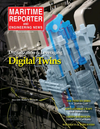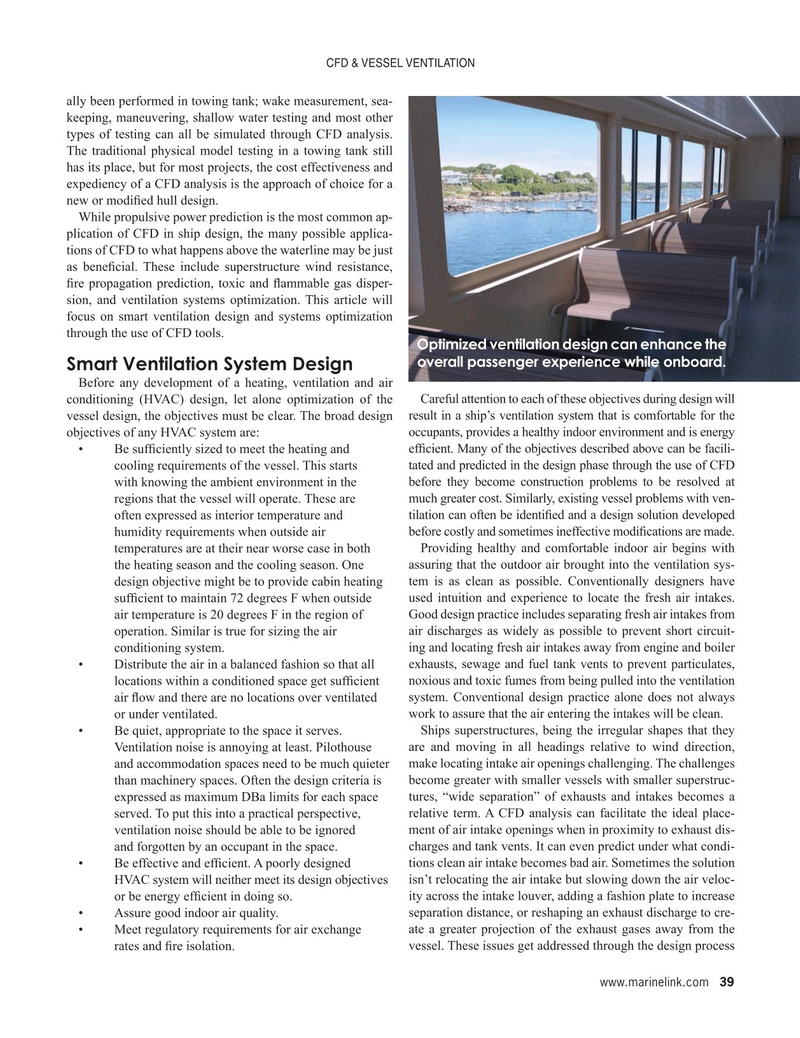
Page 39: of Maritime Reporter Magazine (June 2024)
Read this page in Pdf, Flash or Html5 edition of June 2024 Maritime Reporter Magazine
CFD & VESSEL VENTILATION ally been performed in towing tank; wake measurement, sea- keeping, maneuvering, shallow water testing and most other types of testing can all be simulated through CFD analysis.
The traditional physical model testing in a towing tank still has its place, but for most projects, the cost effectiveness and expediency of a CFD analysis is the approach of choice for a new or modi? ed hull design.
While propulsive power prediction is the most common ap- plication of CFD in ship design, the many possible applica- tions of CFD to what happens above the waterline may be just as bene? cial. These include superstructure wind resistance, ? re propagation prediction, toxic and ? ammable gas disper- sion, and ventilation systems optimization. This article will focus on smart ventilation design and systems optimization through the use of CFD tools.
Optimized ventilation design can enhance the overall passenger experience while onboard.
Smart Ventilation System Design
Before any development of a heating, ventilation and air conditioning (HVAC) design, let alone optimization of the Careful attention to each of these objectives during design will vessel design, the objectives must be clear. The broad design result in a ship’s ventilation system that is comfortable for the objectives of any HVAC system are: occupants, provides a healthy indoor environment and is energy • Be suf? ciently sized to meet the heating and ef? cient. Many of the objectives described above can be facili- cooling requirements of the vessel. This starts tated and predicted in the design phase through the use of CFD with knowing the ambient environment in the before they become construction problems to be resolved at regions that the vessel will operate. These are much greater cost. Similarly, existing vessel problems with ven- often expressed as interior temperature and tilation can often be identi? ed and a design solution developed humidity requirements when outside air before costly and sometimes ineffective modi? cations are made.
temperatures are at their near worse case in both Providing healthy and comfortable indoor air begins with the heating season and the cooling season. One assuring that the outdoor air brought into the ventilation sys- design objective might be to provide cabin heating tem is as clean as possible. Conventionally designers have suf? cient to maintain 72 degrees F when outside used intuition and experience to locate the fresh air intakes. air temperature is 20 degrees F in the region of Good design practice includes separating fresh air intakes from operation. Similar is true for sizing the air air discharges as widely as possible to prevent short circuit- conditioning system. ing and locating fresh air intakes away from engine and boiler • Distribute the air in a balanced fashion so that all exhausts, sewage and fuel tank vents to prevent particulates, locations within a conditioned space get suf? cient noxious and toxic fumes from being pulled into the ventilation air ? ow and there are no locations over ventilated system. Conventional design practice alone does not always or under ventilated. work to assure that the air entering the intakes will be clean.
• Be quiet, appropriate to the space it serves. Ships superstructures, being the irregular shapes that they Ventilation noise is annoying at least. Pilothouse are and moving in all headings relative to wind direction, and accommodation spaces need to be much quieter make locating intake air openings challenging. The challenges than machinery spaces. Often the design criteria is become greater with smaller vessels with smaller superstruc- expressed as maximum DBa limits for each space tures, “wide separation” of exhausts and intakes becomes a served. To put this into a practical perspective, relative term. A CFD analysis can facilitate the ideal place- ventilation noise should be able to be ignored ment of air intake openings when in proximity to exhaust dis- and forgotten by an occupant in the space. charges and tank vents. It can even predict under what condi- • Be effective and ef? cient. A poorly designed tions clean air intake becomes bad air. Sometimes the solution HVAC system will neither meet its design objectives isn’t relocating the air intake but slowing down the air veloc- or be energy ef? cient in doing so. ity across the intake louver, adding a fashion plate to increase • Assure good indoor air quality. separation distance, or reshaping an exhaust discharge to cre- • Meet regulatory requirements for air exchange ate a greater projection of the exhaust gases away from the rates and ? re isolation. vessel. These issues get addressed through the design process www.marinelink.com 39
MR #6 (34-44).indd 39 6/3/2024 11:55:39 AM

 38
38

 40
40
